Ever wonder how many ways there are to brew coffee? Or just want to learn about one brew method in particular? Well, whether it’s French Press, Aeropress or the zillions of Pour Over brewers… you’re in the right place.
This guide to coffee brew methods will tell you how to brew using each method. Pros and cons for every one, so you can figure out which is best for you. I’ll even tell you what I think of each method myself.
Coffee brew methods
1. French Press
2. Pour Over
3. Espresso
4. Autodrip
5. Aeropress
6. Moka Pot
7. Cold Brew
8. Instant Coffee
9. FAQ
1. French Press
The French Press, or Cafetiere or Plunger or Press Pot, depending on where you live. One of the oldest methods of brewing thanks to its simplicity.
Add ground coffee and water in a pot and you’re pretty much done.
It’s then strained through a metal mesh filter which gives the French Press’s trademark rich and full-bodied taste – and the trademark ground coffee sediment in the bottom of your cup!
It’s easy to learn, it’s easy to make. No great skill is required and for that reason, it’s a popular choice among people who are just getting into the whole coffee thing.
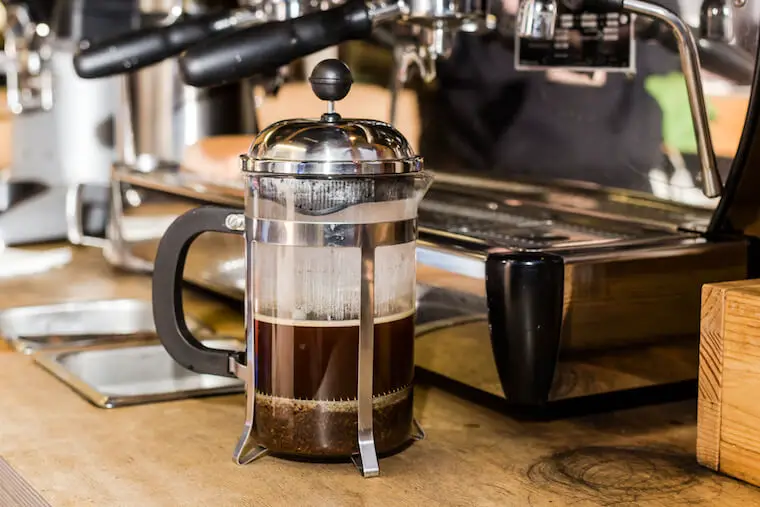
The only issue is brewing coffee in this way is not very forgiving of grind size. If you’re using a cheap burr grinder or (god forbid) a blade grinder then your grounds will be inconsistently sized and contain a lot of very small bits called ‘fines’.
These fines will massively overextract due to the longer brew time and make your coffee a bitter mess. This is a method for those with a decent grinder or at the very least buying it preground.
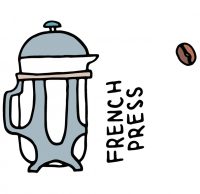
The French Press, despite its simplicity, is popular among coffee veterans and the reason for that is its taste. The mesh filter you find in a French Press does not block the thick coffee oil micro-particulates like a paper filter would.
What you get is a taste that is very full bodied – think how full-fat milk tastes compared to low-fat milk, French Press coffee is like the full-fat milk.
You must bear in mind that this filtering process means some of the finer coffee grounds and particles will make their way into your coffee as the silty sediment that collects at the bottom of your cup.
You can reduce this effect with a good grinder or a good French Press but this sediment will always be present, particularly in your last sip.
French Press’s richer body pairs well with smoky, earthy and nutty flavors which means Asian coffee beans can be a great choice – I’m on a bit of a Northern Thailand / French Press streak myself at the moment. It’s also commonly used with the burnt and charred texture of the dark roasts.
While these dark roasted coffee beans don’t bring out the inherent flavors of the beans they are well-liked and will give a powerful taste that lots of people enjoy.
Pros
Cons
- Rich, full bodied taste. The French Press gives a coffee with a uniquely thick and almost silty taste
- Simple. Adding coffee to water in one of these is a brewing process so simple you could teach most larger mammals how to do it!
- Cheap. A perfectly serviceable French Press can be yours for less than $20. Bargain!
- Sediment. The downside to the full-bodied mouthfeel is the sediment that collects in your cup and ruins your last sip.
- Low complexity. The thick mouthfeel can muddy up the flavor compared to methods that filter out the thicker coffee oils and micro-particulates.
- Unforgiving of bad grind. The long brew time means that an inconsistent grind full of fines will overextract and leave a bitter taste in your coffee.
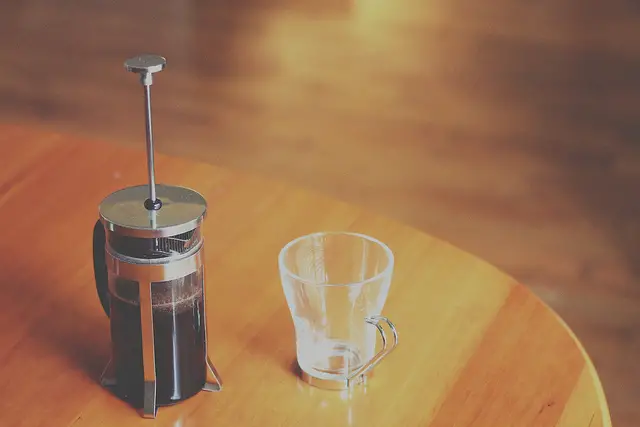
My Opinion On The French Press
I like the French Press and I use it a lot. When I first buy a new batch of beans that I’ve never tried before, I like to experiment with my brewed coffee. Pour Over, Aeropress, Cold Brew.
Trying different methods gives me a great feel for the coffee bean and its flavors. One method that I never skip is the French Press, and that’s because of its unique, full-bodied taste.
Is it my go-to way of making coffee? No. It’s a bit muddy for me to use on a day-to-day basis and I hate cleaning it – I can never seem to avoid huge amounts of ground coffee ending up in my sink.
However, it does have a few uses. It is excellent if I want to make a batch of coffee to share with someone and great if I want to shake things up a bit.
2. Pour Over
First off, there’s an absolute boatload of Pour Overs out there and they differ to a reasonable degree, so I’m going to try to keep things broad here. If your heart does end up being set on this method then I’ve got an in-depth article comparing 6 of the main players you can look into
Pour Over is in vogue at the moment.
This method is the heart and soul of the hip third wave coffee movement. With the introduction of spiral pours, gooseneck kettles and ethically sourced coffee beans, it seems like everyone and their dog is offering a new Pour Over device that will shake up the world of coffee like all the others did.
From the elegant glass-blown curves of the Chemex to the ridged engineering of the Hario V60 and from the modern Japanese design of the Kalita Wave to the forgiving contraption of the Clever Coffee Dripper.
There’s a million of these out there and they all perform roughly the same job: make damn good coffee.
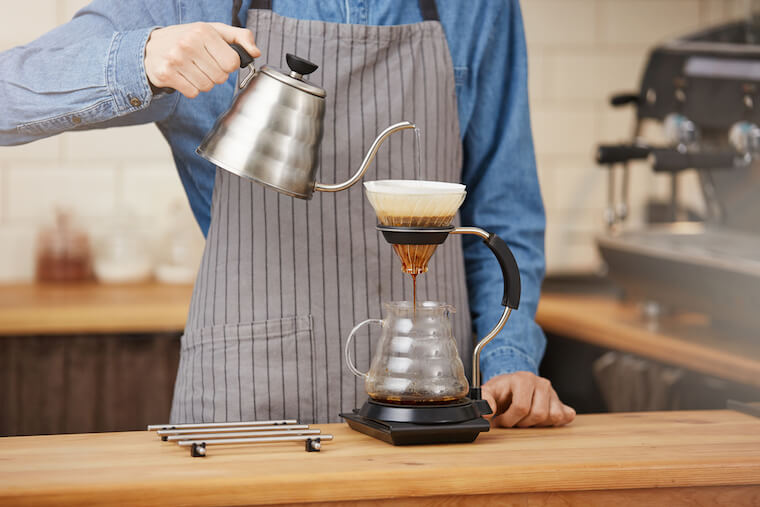
Pour Over coffee is known for producing a bright coffee. In layman’s terms, you’re getting coffee that will highlight the lighter and more acidic notes. For example, bright coffee really enhances the lemony notes of the famous Ethiopian Yirgacheffe.
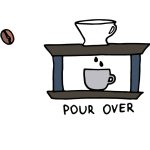
It also is a great method for flavor clarity (or complexity).
The filters trap a lot of the thicker coffee oils and micro-particulates that make the coffee richer but also a bit muddier.
This lets the flavor be tasted more easily which is what people mean when they talk about coffee having high clarity or complexity.
A couple of exceptions: You’ll get a far richer but muddier cup if you use the Able Kone filter and a much cleaner and brighter cup with the Chemex.
Again, this article is already far too long so if you’re interested in the specifics of some of the key players then check this out.
Pros
Cons
- Cheap. Less than $30 for most models gives you more room to invest in that quality grinder that you need.
- Simple. Pour the water over the coffee. It’s not quite on the same level as the French Press in terms of simplicity but it’s still one you can learn in 10 minutes.
- Easy (easiest!) clean up. The grounds collect nicely in the filter which goes straight in the trash! Perfect if you’re as lazy as I am.
- Clean and bright taste. Pour Over has a taste that, when paired with some great freshly roasted beans, really seems to wow people.
- Takes a while. It’s a 3-4 minute brew time that requires you to be present watching your spiral pour + bloom do its magic.
- Other equipment. You will need a gooseneck kettle to get the best out of a Pour Over coffee.
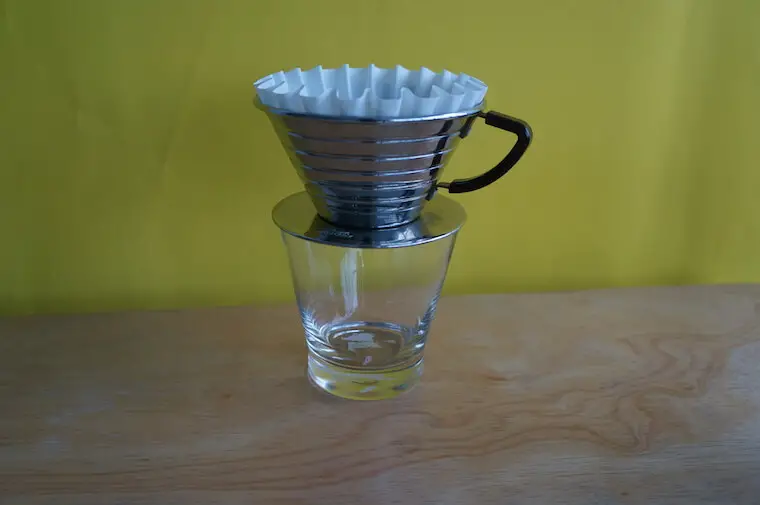
My Opinion On Pour Over
I like Pour Over a lot. I like the wonderfully acidic taste I get and I like how easy it is to clean. I’m enjoying my Kalita Wave at the moment and I find pouring the stream of water from my gooseneck kettle into it gives me a zen-like feeling.
(At least until I look around at the complete state that my kitchen is usually in!)
The only downside is it’s not a quick method for making coffee. There’s a reason why you don’t often see Pour Over coffee shops. If you make a French Press then you can go and do something else, with Pour Over you have to watch and pour, watch and pour…
If I’m going for the clean, bright taste produced when using a paper filter I’ll usually go for the super fast option of the Aeropress.
Incidentally, I went to one in San Francisco a while ago and it was like a doctor’s waiting room with the number of people sat around waiting for their pour over to be made!
3. Espresso
Espresso should need no introduction. Since the second wave of coffee in the 60s/70s the landscape has become littered with coffee shops offering you all those exotic Italian-sounding drinks. Is your favorite the latte or the cappuccino? Maybe even the boring old americano?
A difficult craft to learn and a very difficult craft to master. Don’t be put off by the one-button-press that the baristas do at your local mega-chain corporate coffee shop.
People spend years perfecting the skill of espresso, hoping to eventually be able to pull off a god shot. And those baristas are probably using super-automatics which could be operated by a well-trained monkey.
It’s an expensive hobby to get into properly. I wouldn’t recommend choosing this option as a beginner, because of the cost and because of the difficulty.
Spend that money on a good quality grinder, choose another option on this list and learn how to get a good extraction with the more forgiving methods. Once you understand the factors that change how good your brewed coffee is you can delve into the uncompromising world of making your own espresso.
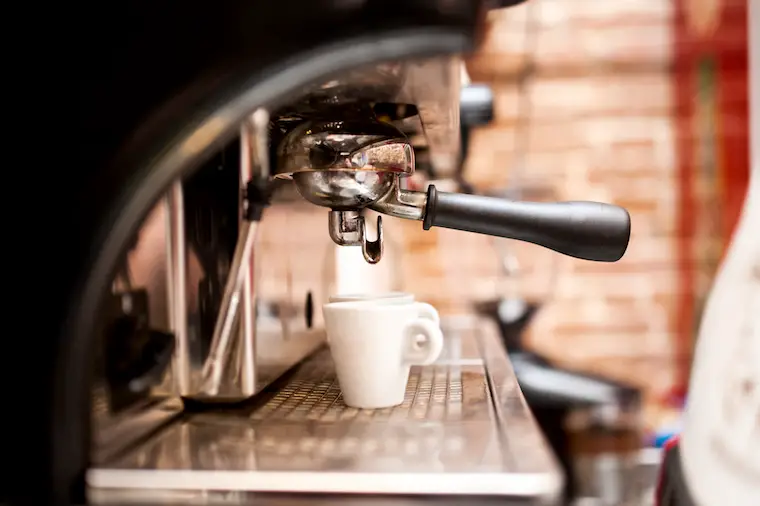
Espresso is a small shot of very strong coffee. A common misconception is that espresso should taste bitter, strong, burnt and charred. This is mostly wrong. Espresso, like all coffee, will take on the characteristics of the bean and roast and will not taste overly bitter or sour if it’s been properly extracted – ie. the barista has done their job properly.
While espresso is often taken straight, the taste of espresso coffee can (and usually is) altered in millions of different ways.
From the brewed coffee-lite Americano to the milky paradise of the Latte and from the briefly extracted beauty of the Ristretto to the Italian breakfast of the Cappuccino, there’s bucketloads of customization. You probably already have a favorite if you’ve gone to a coffee shop at all in the last century. Get an espresso machine and you’ll have ten favorites.
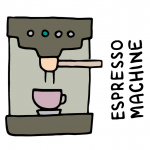
I highly recommend you try fantastic espresso (just espresso) at least once. Avoid the large chains and find somewhere independent that knows what it’s doing.
It’s a bit more hassle than walking down the road to Starbuck’s, but so worth it. It’s a revelatory experience the first time you realize how good espresso can be without all that sugar and milk.
One other point is that darker roasts and more balanced blends are used in espresso and there is a place for the more bitter Robusta coffee beans.
The highly concentrated nature of the drink means coffee beans that give you delightful acidic notes like blueberry, lemon or jasmine when making brewed coffee can end up being a sour disaster when making espresso.
Pros
Cons
- Can make espresso drinks. If your heart is set on a latte or cappuccino, then this is your only option.
- Considered the high point of coffee making. For better or worse, this is the holy grail. Or rather, this is.
- An excellent craft to learn about. Getting an espresso machine is where coffee making turns from a hobby to an obsession.
- Cost. You have to spend a decent amount to get a good setup at home.
- Not simple. You have a lot of learning/practice/foul-tasting brews before you can do it well.
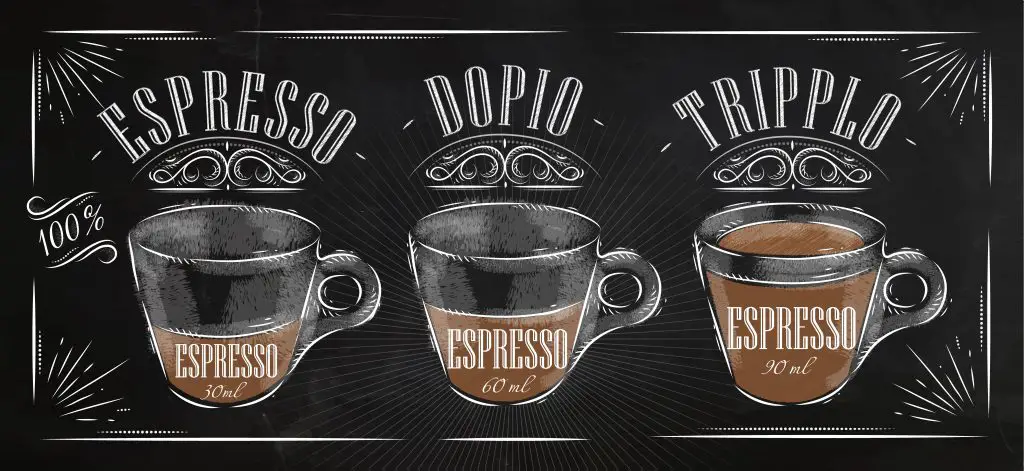
My Opinion On Espresso
I have loved espresso coffee since visiting my best friend’s third wave coffee shop/roasters many years ago. He insisted that I have espresso – straight espresso – and it just blew me away. The light, delicate notes, and flavors were exquisite.
I couldn’t believe espresso could taste like this, I was used to smoky, burnt, bitter espresso that just tasted way too strong and was crying out to be rescued by heavy doses of milk and sugar. This was different, delicious and quite a revelatory experience for the young Pat.
(I should mention it wasn’t my friend who made the espresso, it was his boss!)
I do own a decent espresso machine that I use regularly. Despite having been using it pretty much daily for years I do not in anyway consider myself an expert. That in itself is a lesson.
It’s not something you can pick up and make magic with instantly. It will take time and effort to make quality espresso. But the rewards are very sweet.
4. Autodrip
Now we’re moving on to that all-American classic, the autodrip coffee maker.
How many of these are dotted around the country in the corners of hotel rooms or on family kitchen counters?

Don’t let the hipsters deceive you, there is little difference between autodrip and pour over coffee. It’s practically the same method. Water is dripped down over ground coffee then run through a filter.
The autodrip is just an automation of this process. On the other hand, Pour Over does tend to give you more customization in terms of funnel shape and type of filter, also there is an emphasis on using a pulse pour and other techniques.
The autodrip coffee maker gets a bad rep for making bad coffee, quite correctly in many cases. You need to be sure you’re buying a machine that is capable of creating the conditions that produce great coffee. They do exist.
The trick is to buy a coffee maker that has SCAA certification – the gold standard for autodrip coffee makers. Get one of these bad boys and you’ll be making brewed coffee as good as any Pour Over can.
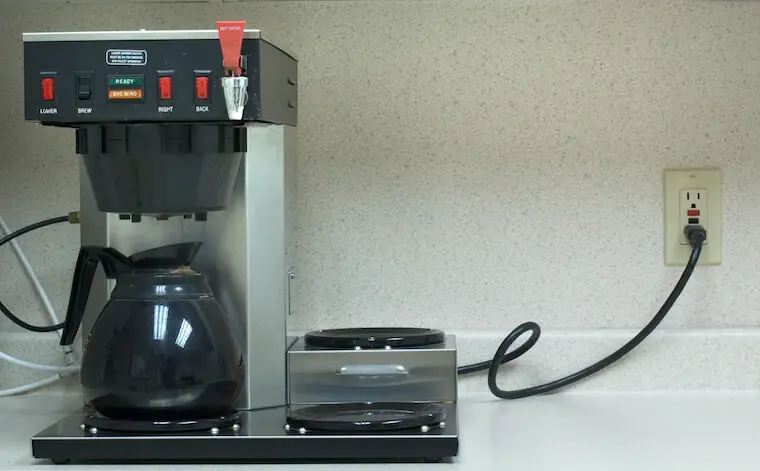
The autodrip coffee maker uses percolation (drip method) and typically a paper filter. The method is very similar to Pour Over, the differences being that Autodrip is automated with a slow drip and uses standard sized filters whereas Pour Over is done by hand, often using a pulse pour and comes in various sized devices and filters. As a result, the taste is very similar.
You can expect a taste that is clean and bright, low in body but high in flavor clarity.
In layman’s terms, you’re getting coffee that will highlight the lighter and more acidic notes.
For example, bright coffee really enhances the lemony notes of the famous Ethiopian Yirgacheffe.
It also is a great method for flavor clarity (or complexity). The filters trap a lot of the thicker coffee oils and micro-particulates that make the coffee richer but also a bit muddier. This lets the flavor be tasted more easily which is what people mean when they talk about coffee having high clarity or complexity.
NOTE: You can get plastic mesh filters that trap fewer of the coffee oils and particles that enrich the coffee so you end up with a fuller cup with a thicker mouthfeel. I have little experience using these so I’m not speaking from experience here, FYI.
Pros
Cons
- Convenience. The easiest method there is – outside of instant.
- Considered the high point of coffee making. For better or worse, this is the holy grail. Or rather, this is.
- Time. It’s not that quick to brew, but it is very quick to setup. Take 60 seconds putting it on and then you can come back in a few minutes to freshly brewed coffee.
- Cost. You’re looking at $100-200 for a purchase that will really make you happy.
- Large device. Bad for traveling and small kitchens.
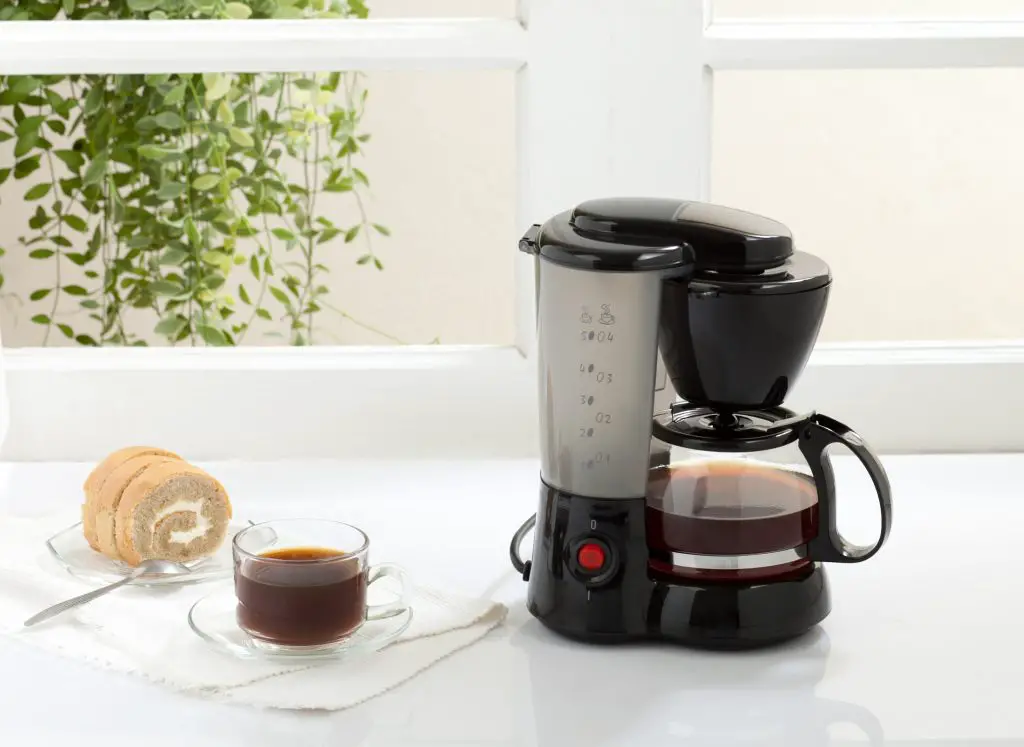
My Opinion
I was put off drinking from coffee makers for many years. When I was a kid, the coffee maker was that thing my aunt had that made that bitter brown stuff that stank up the kitchen. Whether it was by association or something else, I avoided them throughout my initial stages of coffee drinking.
It turns out this was with good cause. A large percentage of coffee makers simply aren’t up to the task, you need to look at SCAA certification to find ones that are.
I don’t own one myself right now but I’ve used many of the better models. (Better meaning SCAA-certified). They are great, these days. They’re super convenient, low hassle and even make my list of the top 4 most forgiving methods for beginners.
They also make a great gift for an older relative who loves a coffee but would not love the fine tuning of dialing in a V60 brew.
You also have the option of buying one with an auto timer, set it at night and wake up to the smell of brewed coffee! If I was less obsessive about coffee I’d probably do this due to my other obsession: laziness.
5. Aeropress
Invented in 2005, Aeropress is the newcomer on the coffee scene. It’s a modern looking device, made of (very strong) plastic and has a brewing method that is all its own.
It’s a testament to the design of the Aeropress that it has grown so popular in such a small amount of time.
Its popularity is such that there is even a yearly Aeropress World Championship held by coffee enthusiasts!
The Aeropress works through a combination of immersion and pressure and will produce a small amount of strong coffee ‘concentrate’. This is like your standard brewed coffee but much thicker and so it can be used like espresso to make drinks such as Cappuccinos and Lattes.
Do bear in mind though, that it is not real espresso which can only be made with a high pressure (9-bar) espresso machine.
This device is great for travelling, forgiving for the beginner and has a million different ways you can brew it including the infamous inverted method.
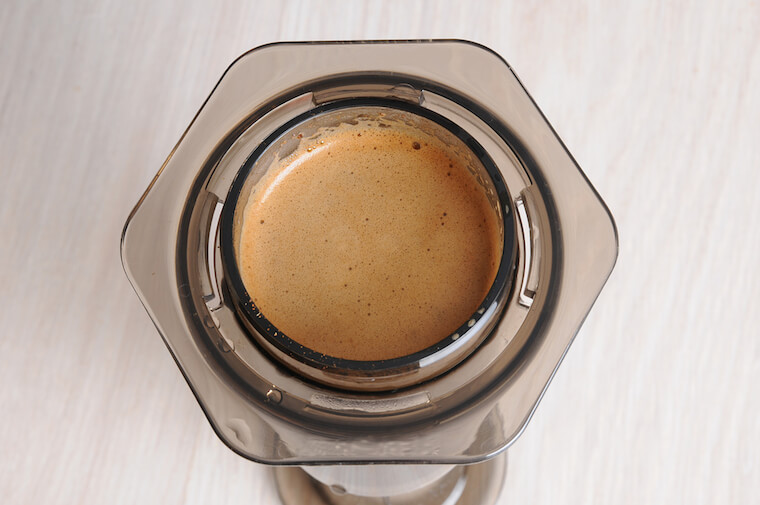
The Aeropress has a unique brewing style. French Press-style immersion brewing for 10 seconds then Espresso-style pressurizing the coffee through a filter.
Aeropress coffee produces a taste that is bright, light and smooth – in the same ballpark as Pour Overs and other paper-filtered methods.
It is slightly less rich but highlights the softer, fruitier notes in the coffee.
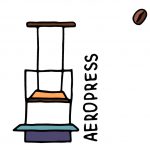
The coffee has little body. The paper filter catches the thicker coffee oils that make the cup feel rich, but also means you have a cup free of sediment. That means that the coffee feels less thick than the heavy body taste of, for example, a French Press coffee.
The manufacturer claims it is low in acidity compared to other methods from their own testing. An interesting claim, but I’m not sure I agree with them based on my own experience. Try it for yourself!
The rich coffee concentrate is great if you like drinking coffee strong and really getting a feel for the flavor and tasting notes. If you thought the notes of lemon were popping out in your normal brewed coffee then wait till you get your lips around a strong shot of Aeropress coffee!
Whether your coffee has notes of blueberry or jasmine, they’ll positively sparkle when using this method.
Pros
Cons
- Convenience. The easiest method there is – outside of instant.
- Considered the high point of coffee making. For better or worse, this is the holy grail. Or rather, this is.
- Good travelling option. Small and compact, fits snugly into your luggage.
- Very forgiving on a poor grind consistency. The fine grind used means you can get better brews with cheap grinders.
- Fiddly. You need a bit of dexterity to make your coffee and if you’re as clumsy as I am you will spill it on occasion.
My Opinion
I’m a big fan of the Aeropress. It makes great coffee with a lovely, smooth taste and the equipment is cheap at just $30.
I use mine pretty regularly – it’s my goto when I need a coffee made quick! I can make a brew in less than 3 minutes. No mean feat when you measure your coffee weight, water weight, grind your beans, wait for the kettle to boil etc.
A point I don’t see people bring up too much is how useful it can be for a beginner. The process of making Aeropress isn’t that simple, but the short brew time and fine grind is a godsend for those with cheap burr or blade (god forbid) grinders.
The fine grind needed reduces the chance of overextraction, one of the most common coffee making bugbears that makes your coffee overly bitter and is the main reason (I think) people get turned off brewing their own coffee.
The Aeropress is easy to clean, you won’t be spending an age each morning washing the damn thing. It’s also great for travelers, light, small and all you need is some hot water. I don’t know anyone who’s unhappy with theirs.
There’s a good reason it’s caught on like wildfire!
6. Moka Pot
The Moka Pot is best explained by its other, much more descriptive name, the stovetop espresso maker. Pop it on your stove and let it work its magic! This little guy was invented in Italy about 70 years ago as a way to make espresso coffee that doesn’t require a large and expensive machine. It still is very popular in some European and Latin American countries.
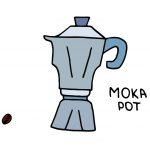
It’s cheap, light and portable. You can get a quality Moka Pot for less than 20 bucks and it’s so small that it’ll fit in any suitcase. And the water can be heated in the Moka Pot, so you don’t even need a pan or a kettle. A traveler’s dream!
So what’s the catch?
Well, it doesn’t technically make espresso. ‘Espresso’ in the original Italian means ‘pressed’. It is made with a high amount of pressure that only espresso machines can exert – about 9 bars. A Moka Pot can’t produce anything over 2 bars.
A Moka Pot makes something between espresso and brewed coffee.
So it’s kinda like a strong coffee or a larger and weaker espresso. Hence the term ‘Moka’ is used.
For many people, the espresso-like coffee is perfect. And it can still be used to make hybrid Americanos or Lattes.
Aside from anything else, they are beautiful little devices that look great in a cute kitchen. Mine gets more questions from guests than basically anything else I own!
(Usually questions like ‘what the **** is that?’)

The Moka Pot shares the faux-sspresso niche with the Aeropress. Both devices produce a strong coffee concentrate – although Moka comes much closer to real espresso in my opinion. If you use one of these you can be making your own lattes, cappos and so on. Of course, you’re not here to find out the taste of a milky latte though!
Broadly speaking, black Moka coffee is bright, highlighting lighter and fruitier notes very strongly. The effect will be lessened if you dilute the shot of strong coffee ‘concentrate’ with water or milk, however.
It’s a trickier process than most of these methods, it can be easy to underextract and end up with an unpleasant sourness.
The key is to watch your grind size like a hawk and adjust and make it finer if this happens.
Even more so than other methods, a good quality hand or automatic grinder is essential to really dialing in your brew.
The coffee will also come out strong. You’re usually looking at using a 1:10 or 1:11 ratio (more on this in my brew guide) – at least that’s if you fill the basket and lower chamber to the brim with coffee and water. It’s not as strong or concentrated as a straight espresso shot but it’s not too far away.
And you can experiment with stronger ratios if you want by simply using less water. Of course, buying a scale to see exactly is always the best idea.
Pros
Cons
- Cheap way to make ‘espresso’. This is, in my opinion, the best of the ‘faux-spresso’ options.
- Lets the brighter notes shine… … perhaps more than any other method.
- Good travelling option. It’s small and can be used straight from the stove.
- Lots of pitfalls that will ruin your brew. A tricky method where you will need to pay close attention to a good brew guide.
- Time. Time from start to finish is more than other methods. It can be infuriating watching the coffee slowly drip upwards. More so if you let the water boil inside the Moka Pot rather than preboiling.
- Won’t work with induction stove. At least, I’ve not come across one that does.
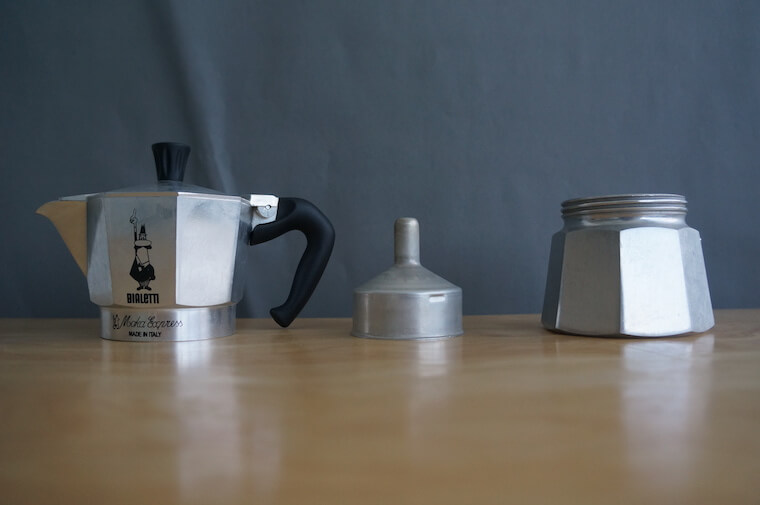
My Opinion
The Moka Pot is a fantastic little device that makes excellent, bright coffee with a minimum of equipment. The Moke Pot is also, unfortunately, a fickle mistress.
Although the process seems simple, it’s very easy to make a bad cup. One that tastes burnt, sour, metallic-tasting or worse…
I’ve mentioned how important grind size is, now throw in the option to boil or use pre-boiled water, making a ‘lungo’ to avoid a metallic taste from too much aluminum deposits, packing but not tamping the coffee and getting the right heat on your stove.
Learning how to avoid the many pitfalls of the Moka Pot can be quite the schlep, luckily I have a great guide waiting for you here.
My only other grievance is that it feels like it takes more time than other methods. In between the finer grind (which requires more effort and/or time) and waiting for the water to boil on the stove rather than use my electric kettle, It’s something I save for lazy weekends or at least when I have a bit of time on my hands.
I can’t imagine fitting this in between shower and toast in my morning routine!
One other point worth mentioning, most (at least the ones I’ve used) will not work on an induction stove. My friend moving into a new place that had one is why I owned my first ever Moka pot, incidentally!
7. Cold Brew
The coolest thing to catch fire in the coffee world in the last few years is Cold Brew. It seems like it’s impossible to go to a third wave coffee house without being bombarded with advertisements for the locally produced specialty Cold Brew.
A refreshing glass of ice filled with coffee that has been brewed over 48 hours can be just the ticket on a scorching summer’s day.
Cold Brew is a fantastic choice for a beginner.
The process is straightforward, there’s little risk of over-extraction and it’s renowned for its low acidity. It’s also much more forgiving of grind size, perfect for those starting out with a cheap grinder.
In fact, it even makes number one in my list of the Top 4 Most Forgiving Ways to Make Coffee.
Its few downsides are that the flavors are slightly muted, making a great brew less spectacular than you might want – particularly if you are using high-quality coffee beans. Another drawback might be that you have to drink your coffee cold. But hey, you knew that anyway!
It also is not efficient. If a pound of coffee usually makes you 20 cups then you might get 10-15 cups from using Cold Brew for the same strength.
And this is where the big secret lies… Use cheaper coffee beans. The taste can still be pretty great with those $6 a pound bottom-shelf grocery store rubbish.

Cold Brew uses an immersion/steeping process similar to that of a French Press. The process takes a day or two and is then filtered using a paper filter. This retains a lot of the larger coffee particles and oils which give a full-bodied texture and richer palate that highlights earthier tones.
The brewing process will produce highly concentrated coffee. You can drink it straight – as I like to – or use water, sugar, milk or ice to create something more palatable. A simple 1:1 with room temperature water in a glass full of ice will work like a charm if you don’t know where to start.
Actually, there’s hundreds of recipes out there if you really want to spice up your Cold Brew game.
The natural flavors of Cold Brew coffee are somewhat muted.
Still present, but slightly dulled. You may think this is a bad thing but it has its notable plus points.
Firstly, this is the ideal method for those who have trouble with stomach acidity, Cold Brew brewing is famous for its ability to leave virtually no trace of the acidic notes of a coffee as a result of its process.
I’ve never had an issue myself but I know people who love their Toddy because the coffee is so gentle on their stomach. Secondly, Cold Brew coffee is very forgiving of lower quality beans for the same reason.
Pros
Cons
- Very simple. A method where it’s pretty difficult to do anything wrong.
- Quick setup. You can setup a brew that will give you many drinks in as little as 20 seconds.
- Low in acidity. Best method there is for low acidity.
- Long brewing time. The 24 hour brew time might be a bit much for those who can’t plan ahead.
- Muted flavors. The sparkling blueberry notes in your African SO are not going to pop in quite the same way with Cold Brew.
- Inefficient. It takes more coffee beans than other methods to produce the same amount of brewed coffee.

My Opinion
I like Cold Brew coffee a lot. I have always loved iced coffee and this ticks the box as a great tasting iced coffee. It’s super convenient, too. Wake up and chuck some of your Cold Brew mix in some ice and you’ve got a morning kickstart ready in seconds.
As I mentioned above, Cold Brew is perfectly suited for cheaper coffee beans. I’m not going to waste my $20 bag of Costa Rican Tarrazau on this method, I’ll get far fewer cups out of it and the strong flavors won’t shine so bright.
But the half a bag that was roasted a couple of months ago that I forgot about? That’s perfect for some Cold Brewing!
8. Instant Coffee
I was torn whether to include Instant Coffee on this list. Instant is the red-headed stepchild of the coffee family, scorned and derided by pretty much everyone. In the end, I chose to in the interests of completeness and the fact that Instant does have its uses. I also have a bit of a soft spot for the underdog…
The quality of instant coffee ranges from just about drinkable to absolutely goddamn terrible. Coffee snobs will tell you that it’s all awful but there are passable options out there if you know where to look.
Particularly recently, some startups and some bigger companies have made great strides in improving the freeze-drying process to create coffee that tastes kinda alright.
The only good reason you’ll be drinking this is if you have a pathological need to get your coffee quickly and easily. Convenience is the name of the game, here.
It comes into its own if you’re traveling or only have mere seconds in the morning… For all other purposes, every single other option on this list is better.
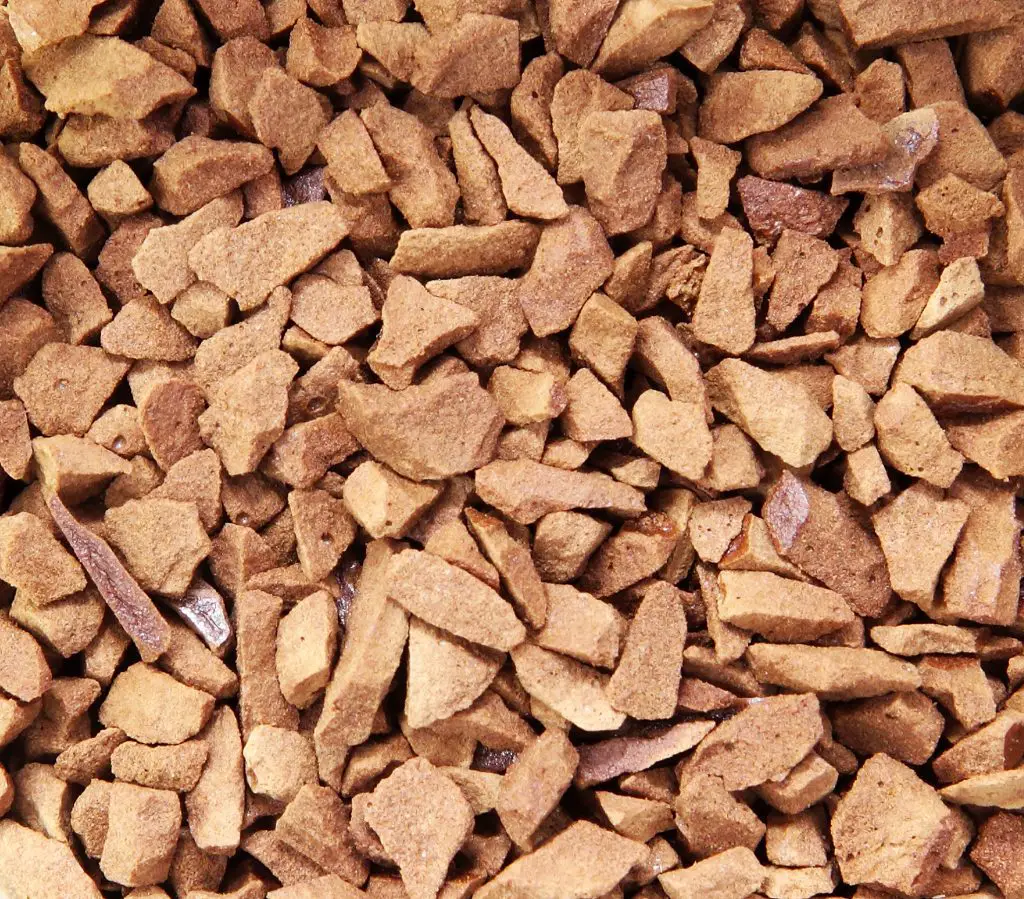
Not a whole lot to say here. Instant coffee is an approximation to real brewed coffee. It is made by brewing coffee as normal then the water is removed to form dry, hard coffee ‘crystals’ that can be rehydrated to recreate the original drink. As you may expect, this process destroys many of the flavors and compounds that make coffee taste nice.
If taste is in any way a priority then you’ll choose another method.
That said, some of the better instant coffees are certainly drinkable.
Just realize that drinkable is as good as it’s ever going to get. Whereas every other method listed here is capable of making coffee that will be the highlight of your day, every single day.
Pros
Cons
- Super fast and convenient. The biggest, and probably only reason why you would drink instant coffee.
- Cheap. It doesn’t cost a lot but it isn’t that cheap, really, especially if you’re going for the ‘higher quality’ stuff.
- Tastes awful. Or at the very least, nowhere near as good as any other method made properly.
My Opinion
I don’t hate instant coffee as much as some. On an embarrassing note, it was how I started drinking coffee. Hot drinks were never something I came near when I was growing up. If you’d asked me if I wanted a tea or coffee when I was younger I would’ve looked at you like you had run over my dog.
So, at the age of about 22 when I first started working, I became enamored with a small vending machine in the corner of our office. It served tiny plastic cups of instant coffee loaded with dried milk and sugar. It seems stupid looking back considering what a coffee snob I now am, but I loved that machine.
It was a sweet, milky treat that cost a buck and woke me up in the mornings, so I can empathize with those for whom convenience trumps everything else.
Also clean up is the easiest thing ever – there is none!
9. FAQ
An important point that’s worth mentioning here: how you make coffee has little bearing on the quality of your drink. You can make great coffee with practically any method.
Don’t think that your cheap $10 French Press can’t produce the good stuff and likewise don’t think that your $1200 espresso machine will give you a flawless cup every time. (In fact, for a beginner it’s a lot easier to make a nice cup with a French Press!)
Below I write a little about the basic rules of making nice coffee.
You Can Make Great Coffee With ANY Method
All these methods (with the exception of Instant) can make fantastic coffee. Equally, they can all be used to produce brown sludge you wouldn’t feed to your dog.
Rather than approaching this with the mindset of ‘which method will make the best coffee?‘ – approach with the mindset of ‘which method is right for me?‘
It’s best to choose your method based on factors like…
– Do I want a more full-bodied coffee? (french press)
– Do I want something small I can travel with? (moka)
– Am I willing to pay more for convenience? (autodrip)
– Do I enjoy the art of learning a hobby? (espresso)
– Do I like a refreshing cold coffee? (cold brew)
– Do I want something that can make coffee super quick? (aeropress)
Think about your priorities and go from there. Or better yet, read the damn article!
How to Actually Make Great Coffee
So, if you can make fantastic coffee with any of these methods, what is it that actually affects the taste of the coffee?
Here’s a list of the main points that will make your coffee so good it sings. They are listed by how important I think they are (my opinion.. not necessarily your friend’s, your local barista’s, the internet’s) and I’ve included links if you really want to get down to the nitty-gritty of learning everything about coffee.
1. High quality coffee beans. Like a gourmet chef using a rotten piece of meat, you cannot make good coffee from poor beans. The region and farm and processing all matter as does getting your beans from a solid roaster.
It’s the difference between the notes of blueberry on your wet-processed Yirgacheffe compared to the factory grade brown swill from the bottom shelf of the grocery store. Honestly, you can screw everything else up but if you get the coffee beans right, you’ll still end up with something pretty nice.
I recommend going local if you can but there’s some great options online too.
2. Good grind consistency. What I mean by ‘grind consistency’ is how even your coffee grounds are. A nice even grind consistency means you can hit the sweet spot of 18-22% extraction of the soluble coffee compound. What you don’t want is to use a cheap burr grinder or (god forbid) a blade grinder.
This will produce ground coffee that is full of fine particles that extract too quickly making your coffee bitter and silty and full of large blocks that barely extract at all making your coffee weak and acidic. You want even grounds, not dust and boulders.
3. Freshly grinding coffee. If you’re serious about making top-tier coffee, you have to grind the beans yourself. Freshness is the order of the day here, and ground coffee will go noticeably stale more quickly than you might think.
If you use preground coffee then your coffee will have lost a lot of freshness within a few hours and be basically dead within a day or two. That said, if it’s the choice between preground or a cheap grinder I think preground is the way to go. I explain my reasoning here.
On points 2 and 3: The quickest way to fast-track yourself to top-tier coffee is by having smoooth, consistent, evenly and freshly ground coffee.
The way to get there is by investing in a high quality burr grinder. Here’s my recommendations on hand grinders and automatic grinders.
Right now $100 is the minimum at the moment although I’m sure some clever startup will produce a respectable $50-75 hand grinder sooner rather than later.
4. Freshly roasted coffee. This is the little brother to point one but it’s so important it deserves its own entry. When some coffee beans are roasted they have a maximum of 30 days before the taste noticeably depreciates.
It’s less than 15 days when they are at their best. Most people actually don’t even realize how good coffee can be and I believe it’s because most coffee they are used to (looking at you SB’s) is out of date.
Luckily, it’s easier than ever to get coffee beans fresh and here’s a clue, it doesn’t involve going to your local grocery store.
5. Good technique. The goal of making good coffee is to get a good extraction. In scientific terms, you need to extract 18-22% of the coffee solids, too much and you get a bitter overextraction whereas too little gives you a sour underextraction.
This requires a balance of temperature, grind size and brew time, as well as a good grind consistency (checkout point 2 again). A small change can make a drastic difference and it’s easy to get it wrong a few times before you start making kickass brews. I recommend checking out my brew guides for many of the different methods of making coffee.
This is also why it’s so important to…
6. Dial it in. In coffee parlance, this means to play around with your brew timings and ratios until you’ve created something magical. A 0.1g scale is pretty much a requirement here.
You need to precisely measure your coffee and water ratio. When you’re just eyeballing it’s easy to get a 1:11 ratio one day and a 1:19 ratio the next.
These become extremely different tasting coffees! You also need to note (mentally or write it down) how you’re making your coffee and tinker with it.
This is not an exhaustive list, but it does cover the main points. If you can make sure you are following the above six items, you will be on your way to making coffee so good you will scarcely believe it.
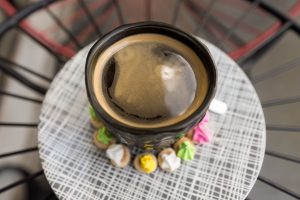
What other methods are there?
*There are several other methods which I will hopefully get round to adding at some point like pods (Keurig etc), Siphon, Turkish.
why are there so many methods?
To brew coffee, you need something to mix the coffee and water in and then something to scoop out the coffee grounds once it’s done. That’s it.
It’s so simple that there are loadsa ways to do it
Conclusion
I love tasting the same coffee brewed in a different manner. It’s a great way to really get to know a coffee. With that in mind, consider having 2 or more different methods.
Some of these methods cost as little as $20 and choosing two contrasting devices will give you a lot of insight into the coffee beans you’re buying.
For example, if you own a French Press and a Chemex Pour Over, you will have one method that gives you a thick feeling coffee with loads of body and another that gives you a lighter, cleaner tasting cup. You’d be very surprised just how different they will taste!
If you’re an absolute coffee noob (short for newbie ;)) then you might be interested in my article on the top 4 most forgiving ways to make coffee or read on for the same information in a longer format.

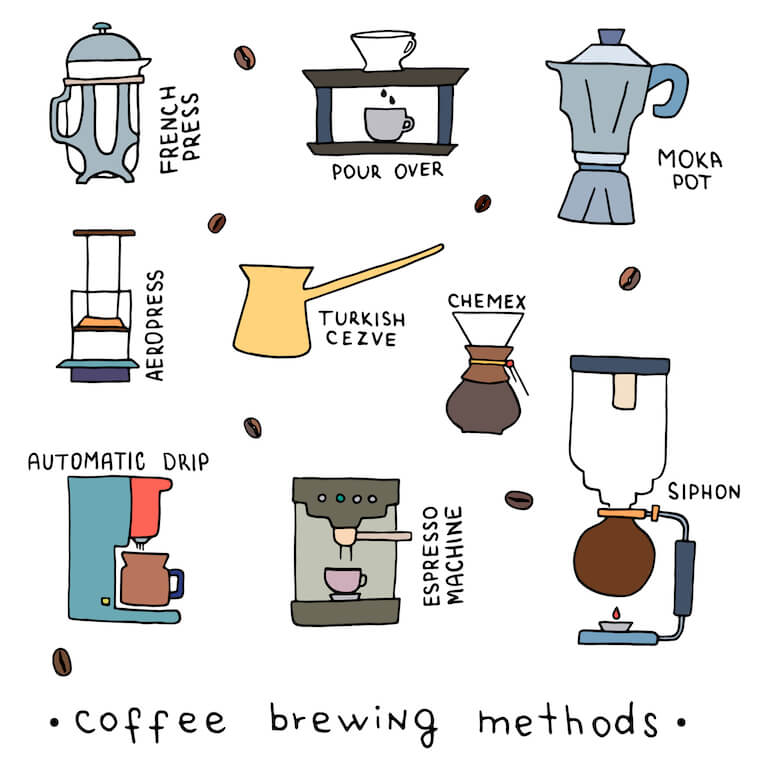
4 Comments
Electric moka solves all the above moka problems. Always brews the same.
Best Regards.
This comprehensive guide would be a huge help for you to brew the best coffee.
I love smooth coffee; none of that burnt and bitter stuff for me. In my humble opinion, the best brewing methods for smooth coffee is Cold-Brew and the AeroPress. Both are fast, easy, and creates a super smooth cup of coffee.
Cheers.